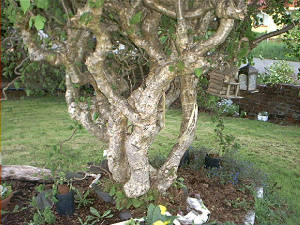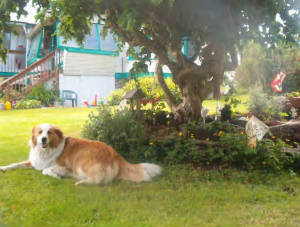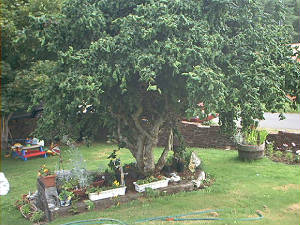
2005 - Our Harry Lauder Walking Stick tree - mature specimen - 15-20 yrs old
Harry Lauder Walking Stick
CONTORTED HAZELNUT
Corylus avellana L. 'Contorta'
This unusual European hazelnut was found around 1850 growing in a hedgerow in England. It has been propagated by cuttings and grafting ever since. The plant has become commonly known as "Harry Lauder's Walking Stick" or "Contorted Hazelnut."
The stems and leaves naturally twist and turn as they grow. The plant would normally grow as a sprawling bush, but if it is grafted onto a 4 ft. tall upright stock (Corylus colurna L. is a good non-suckering rootstock) it forms a very ornamental specimen tree.
Walking Stick : This shrub reaches a height of 8'-10', with a similar spread. The flowers of Harry Lauder's walking stick are yellowish-brown "catkins," as on pussy willows. The blooms appear in early to middle spring. However, this shrub is not grown primarily for its blooms but for its unusual branching pattern, which is indicated by its other common names: corkscrew filbert and contorted hazelnut. For as you can see from the picture, its branches contort themselves in every which way, resembing corkscrews.
Sun and Soil Requirements for Harry Lauder's Walking Stick : Grow Harry Lauder's walking stick in well-drained soil, in full sun to part shade.
Care of Harry Lauder's Walking Stick: Being a grafted shrub, Harry Lauder's walking stick does require some special care. The rootstock is Corylus colurna. As often happens with grafted plants, there is a tendency for suckers to shoot up from the rootstock. You must prune off these suckers so that the plant does not revert to the characteristics of its rootstock.
How Harry Lauder's Walking Stick Got Its Name: According to Adele Kleine of "Flower and Garden Magazine," the shrub's "appealing common name derives from the old Scottish comedian Harry Lauder who performed using a crooked branch as a cane."
Uses for Harry Lauder's Walking Stick in Landscape Design: Harry Lauder's walking stick is a specimen plant. The corkscrew shape of its branches lends much-needed visual interest to the winter landscape.
More on Harry Lauder's Walking Stick: Harry Lauder's walking stick is a case in which one may rightly claim that a deciduous shrub truly comes into its own only after its leaves have fallen. Not that the shrub isn't attractive when fully leafed out. But the eye is especially drawn to this curious specimen in winter, when many other deciduous trees and shrubs are little better than sad reminders of a defunct fall and summer.

our dog, Jake (an Australian shepherd - collie mix),
lays under our Harry Lauder Walking Stick tree - 2005
What is Harry Lauder's walking stick?
By Chelsie Vandaveer
March 11, 2005
At one time, shrubs and trees were planted to separate fields or fields from roads. These hedgerows divided land in a gracious, idyllic way. They were a mix of useful plants neighbors could share—willows for basketry, berries and nuts. A modicum of maintenance kept the hedgerow, a hedgerow. Wildflowers grew there; birds and small animals had refuge in the midst of cultivated lands. The hedgerow stayed the same and yet it changed with the seasons and the passing of the years.
Sometime in the early 1860s, a curious shrub was noticed growing in a hedgerow in Gloucestershire. It was hazel like the hazels (Corylus avellana Linnaeus) that people had cultivated for hundreds of years. But it was different, its branches twisted and corkscrewed and wept. Not many years after the discovery of the contorted hazel, a boy was born at the north
His father died when Harry Lauder was twelve. He helped his mother support his seven siblings by working in a flax mill while he went to school. Later he worked in a coal mine and it must have been difficult to see the stars when one is in 'the pit'. But he clung to his dream—someday he would be a music hall entertainer.
Harry mixed comedy with music and made laughable, yet touchingly lovable characters for his songs—the stodgy Dame, the red-nosed slovenly Calligan, the kilted tight-fisted Roderick McSwankay.
By 1912, Harry was at the top. He was elected to the Rotary Club of Glasgow and his fame spread beyond England. In 1913, he entertained in America; in 1914, he was in Australia. While in Melbourne, the British Empire entered World War I. Harry's son, John left his father's tour and went to war.
Harry, too old to be a soldier, mobilized to do what he could do best, entertain. And entertain he did. Realizing that those soldiers and sailors maimed by the war would be left in poverty, Harry raised huge sums of money for their pensions. Then Harry did something crazy and the war office fought him on the very idea of it all. He took entertainment to the trenches and battlefields of France.
Harry and Ann never saw their son John alive again. In 1919, Harry was knighted for his charitable works. When World War II broke out, he launched himself into another round of entertaining the troops and raising funds. Harry Lauder died in 1950. Few alive today have even heard his name, but entertainers have kept alive the tradition he started—laughter and songs for soldiers and sailors far from home.
It was Harry's wild character, Roderick McSwankay that made the hazel famous. The decked-out Scotsman leaned on an equally crazy hazelwood cane. The shrub became known as Harry Lauder's walking stick.

our Harry Lauder Walking Stick Tree







1 comments:
half of my shrub looks dead or noes not have leaves. The walking stick is now seven years old or so. I want to save the shrub but I do not know what to do to save it. Do you have any suggestions?
Thanks
Post a Comment